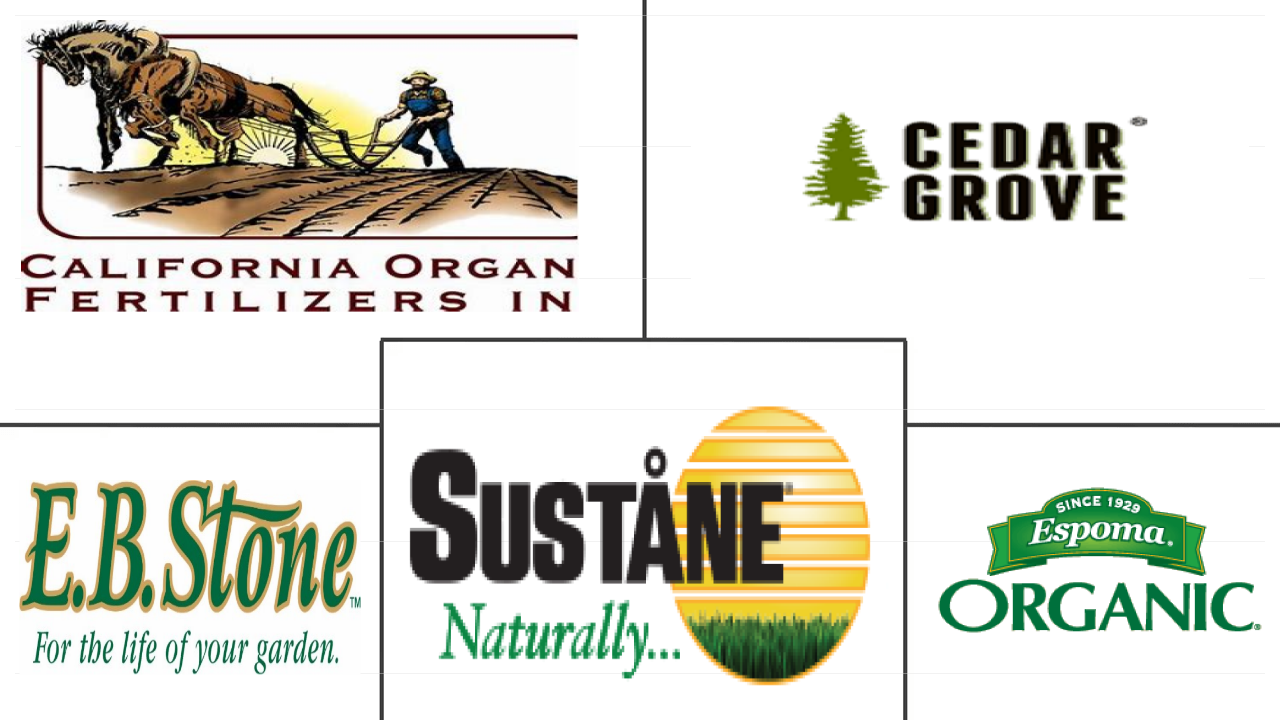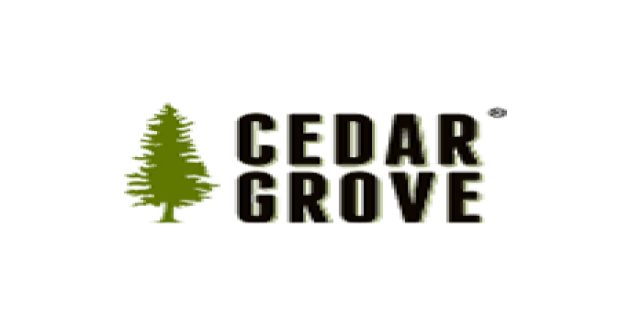Market Size of north america organic fertilizer Industry
| Icons | Lable | Value |
|---|---|---|
|
|
Study Period | 2017 - 2029 |
|
|
Market Size (2024) | USD 0.86 Billion |
|
|
Market Size (2029) | USD 1.49 Billion |
|
|
Largest Share by Form | Meal Based Fertilizers |
|
|
CAGR (2024 - 2029) | 11.70 % |
|
|
Largest Share by Country | United States |
|
|
Market Concentration | Low |
Major Players |
||

|
||
|
*Disclaimer: Major Players sorted in no particular order |
North America Organic Fertilizer Market Analysis
The North America Organic Fertilizer Market size is estimated at 0.86 billion USD in 2024, and is expected to reach 1.49 billion USD by 2029, growing at a CAGR of 11.70% during the forecast period (2024-2029).
0.86 Billion
Market Size in 2024 (USD)
1.49 Billion
Market Size in 2029 (USD)
9.58 %
CAGR (2017-2023)
11.70 %
CAGR (2024-2029)
Largest by Form
49.04 %
value share, Meal Based Fertilizers, 2023
Blood meal (high nitrogen), bone meal (high phosphorus, calcium), and kelp meal (low NPK, rich in minerals) are common meal-based fertilizers used in North America.
Fastest by Form
12 %
Projected CAGR, Manure, 2024-2029
Manure is a natural fertilizer that is applied in organic and inorganic forms. Its usage accounted for the highest share of 41.3% in comparison to other organic fertilizers.
Largest by Crop Type
52.32 %
value share, Row Crops, 2023
Row crops are the significant organic fertilizer-consuming crops in North America. The United States had the most seeded area for row crops and hay, followed by Canada.
Largest by Country
40.97 %
value share, United States, 2023
The United States dominated the market which is attributed to the increased organic agricultural land and government initiatives. Manures accounted for 46.7% in the country.
Leading Market Player
4.33 %
market share, Cedar Grove Composting Inc., 2022

The company manufactures and distributes nutrient rich organic farm compost by recycling the organic waste materials that are otherwise dumped into the landfills.
- Organic fertilizers emerged as a reliable and sustainable source of nutrients for plant growth, offering several advantages over synthetic fertilizers, leading to the increased usage of organic fertilizers by 56.5% between 2017 and 2022. These fertilizers are easily accessible, cost-effective, and provide a moderate concentration of vital elements required for plant growth while minimizing the drawbacks associated with synthetic fertilizers. The rise in adoption can be attributed to the gradual release of nutrients into the soil solution, which helps maintain soil fertility and nutrient balance, leading to proper plant growth.
- Meal-based fertilizers, such as blood meal, bone meal, and kelp meal, are the most consumed organic fertilizers in North America. They accounted for 49.1% of the market share in 2022. These fertilizers are popular due to their high nutrient content, with blood meal being rich in nitrogen, bone meal being high in phosphorus and calcium, and kelp meal being low in NPK but rich in minerals.
- Manures are the second largest organic fertilizers that improve the physiochemical properties of the soil, such as its structure and water-holding capacity. However, manures cannot provide all the necessary nutrients required for crops, as their nutrient content is significantly low. Farmers increasingly turn to other organic fertilizers, such as oilcake and fish guano, to address this issue.
- The growing adoption of organic farming and consumer interest in organic products following the COVID-19 pandemic is expected to drive further growth in the usage of organic fertilizers in North America. These fertilizers offer a sustainable and environmentally-friendly solution for maintaining soil fertility, improving crop yields, and ensuring food security.
- The North American organic fertilizers market is currently dominated by the United States, which accounted for approximately 40.7% of the market value in 2022. This domination is largely due to the country's large organic cultivation area, which accounted for 39.6% of the total North American organic crop area in 2022. In second place is Mexico, which accounted for 33.4% of the region's organic fertilizers market value in 2022. Mexico's total organic crop area is also increasing, with a projected growth of 10.9% to reach 610.0 thousand hectares by 2028.
- Canada accounted for approximately 25.5% of the total organic fertilizer market value in the region in 2022. The country has recently received an investment from the Ministry of Agriculture and Agri-Food to support the sustainability and expansion of its organics sector, which is anticipated to drive the Canadian organic fertilizer market and record a CAGR of 11.2% during the forecast period.
- The Rest of North America, which includes countries like Costa Rica, Cuba, Jamaica, and Guatemala, saw an increase in organic acreage by 10.3% between 2017 and 2022, reaching 5.5 thousand hectares in 2022. Cash crops such as coffee, sugar, cocoa, and spices are the major crops grown in these countries, and they accounted for 93.6% of total organic acreage in 2022.
- The North American organic fertilizer market is driven by the increasing demand for organic crops and the need for sustainable agriculture practices. As more countries and companies invest in the organic agriculture sector, the market is expected to grow in the coming years.
North America Organic Fertilizer Industry Segmentation
Manure, Meal Based Fertilizers, Oilcakes are covered as segments by Form. Cash Crops, Horticultural Crops, Row Crops are covered as segments by Crop Type. Canada, Mexico, United States are covered as segments by Country.
- Organic fertilizers emerged as a reliable and sustainable source of nutrients for plant growth, offering several advantages over synthetic fertilizers, leading to the increased usage of organic fertilizers by 56.5% between 2017 and 2022. These fertilizers are easily accessible, cost-effective, and provide a moderate concentration of vital elements required for plant growth while minimizing the drawbacks associated with synthetic fertilizers. The rise in adoption can be attributed to the gradual release of nutrients into the soil solution, which helps maintain soil fertility and nutrient balance, leading to proper plant growth.
- Meal-based fertilizers, such as blood meal, bone meal, and kelp meal, are the most consumed organic fertilizers in North America. They accounted for 49.1% of the market share in 2022. These fertilizers are popular due to their high nutrient content, with blood meal being rich in nitrogen, bone meal being high in phosphorus and calcium, and kelp meal being low in NPK but rich in minerals.
- Manures are the second largest organic fertilizers that improve the physiochemical properties of the soil, such as its structure and water-holding capacity. However, manures cannot provide all the necessary nutrients required for crops, as their nutrient content is significantly low. Farmers increasingly turn to other organic fertilizers, such as oilcake and fish guano, to address this issue.
- The growing adoption of organic farming and consumer interest in organic products following the COVID-19 pandemic is expected to drive further growth in the usage of organic fertilizers in North America. These fertilizers offer a sustainable and environmentally-friendly solution for maintaining soil fertility, improving crop yields, and ensuring food security.
| Form | |
| Manure | |
| Meal Based Fertilizers | |
| Oilcakes | |
| Other Organic Fertilizer |
| Crop Type | |
| Cash Crops | |
| Horticultural Crops | |
| Row Crops |
| Country | |
| Canada | |
| Mexico | |
| United States | |
| Rest of North America |
North America Organic Fertilizer Market Size Summary
The North America Organic Fertilizer Market is experiencing significant growth, driven by the increasing demand for sustainable agricultural practices and organic products. Organic fertilizers are gaining popularity due to their ability to provide essential nutrients for plant growth while minimizing the environmental impact associated with synthetic fertilizers. The market is characterized by a diverse range of products, with meal-based fertilizers such as blood meal, bone meal, and kelp meal being the most consumed due to their high nutrient content. The adoption of organic farming practices has been further accelerated by the COVID-19 pandemic, as consumers increasingly seek organic products. This trend is supported by government initiatives and investments aimed at promoting organic agriculture across the region.
The United States dominates the North American organic fertilizer market, supported by a large organic cultivation area and a robust demand for organic products. Mexico and Canada also contribute significantly to the market, with Mexico being a major exporter of organic coffee and Canada receiving government support to expand its organic sector. The market is fragmented, with key players like California Organic Fertilizers Inc., Cedar Grove Composting Inc., E.B.Stone & Sons Inc., Suståne Natural Fertilizer Inc., and The Espoma Company leading the industry. These companies are expanding their production capabilities to meet the growing demand for organic fertilizers, which is expected to continue its upward trajectory in the coming years.
North America Organic Fertilizer Market Size - Table of Contents
-
1. MARKET SEGMENTATION (includes market size in Value in USD and Volume, Forecasts up to 2029 and analysis of growth prospects)
-
1.1 Form
-
1.1.1 Manure
-
1.1.2 Meal Based Fertilizers
-
1.1.3 Oilcakes
-
1.1.4 Other Organic Fertilizer
-
-
1.2 Crop Type
-
1.2.1 Cash Crops
-
1.2.2 Horticultural Crops
-
1.2.3 Row Crops
-
-
1.3 Country
-
1.3.1 Canada
-
1.3.2 Mexico
-
1.3.3 United States
-
1.3.4 Rest of North America
-
-
North America Organic Fertilizer Market Size FAQs
How big is the North America Organic Fertilizer Market?
The North America Organic Fertilizer Market size is expected to reach USD 859.42 million in 2024 and grow at a CAGR of 11.70% to reach USD 1.49 billion by 2029.
What is the current North America Organic Fertilizer Market size?
In 2024, the North America Organic Fertilizer Market size is expected to reach USD 859.42 million.

